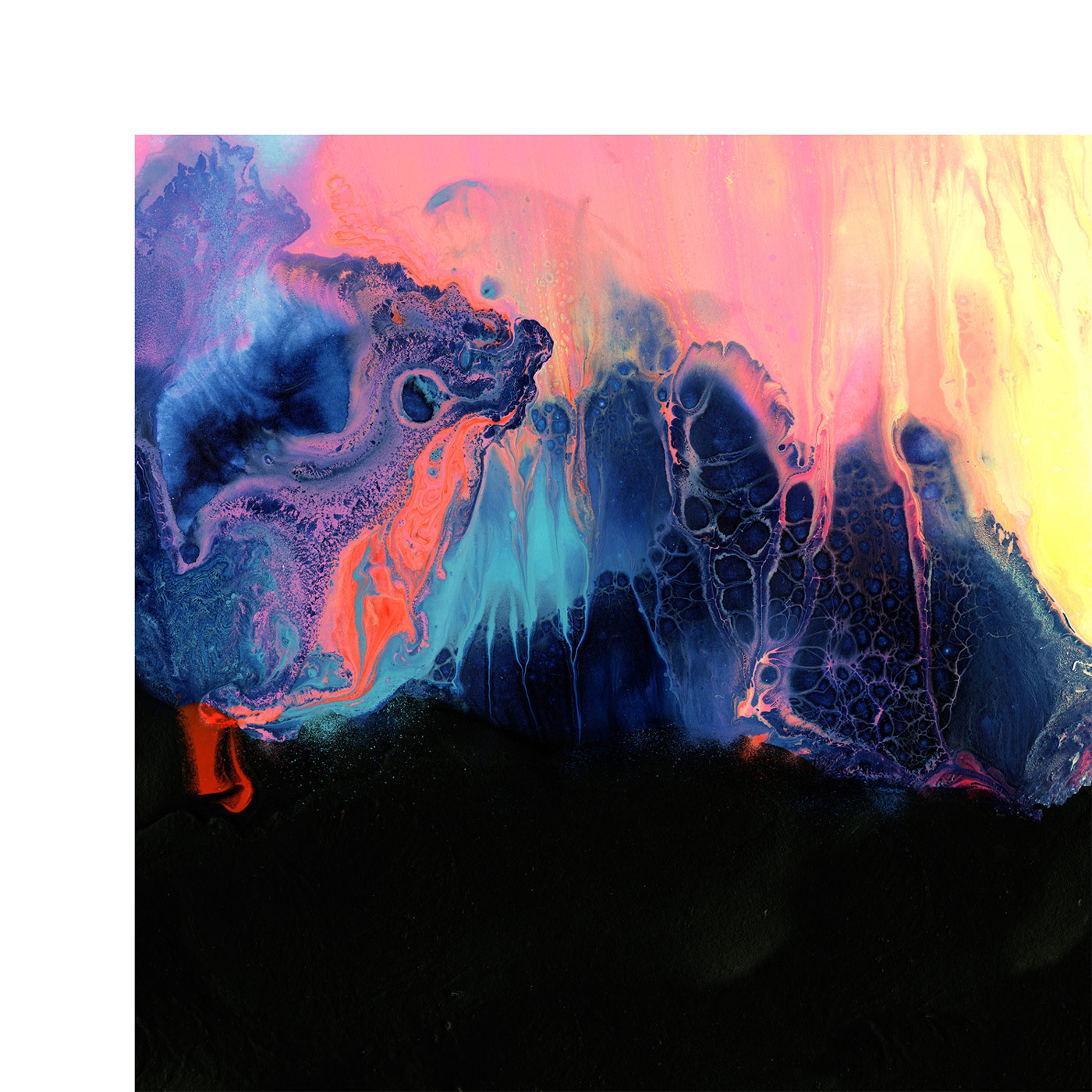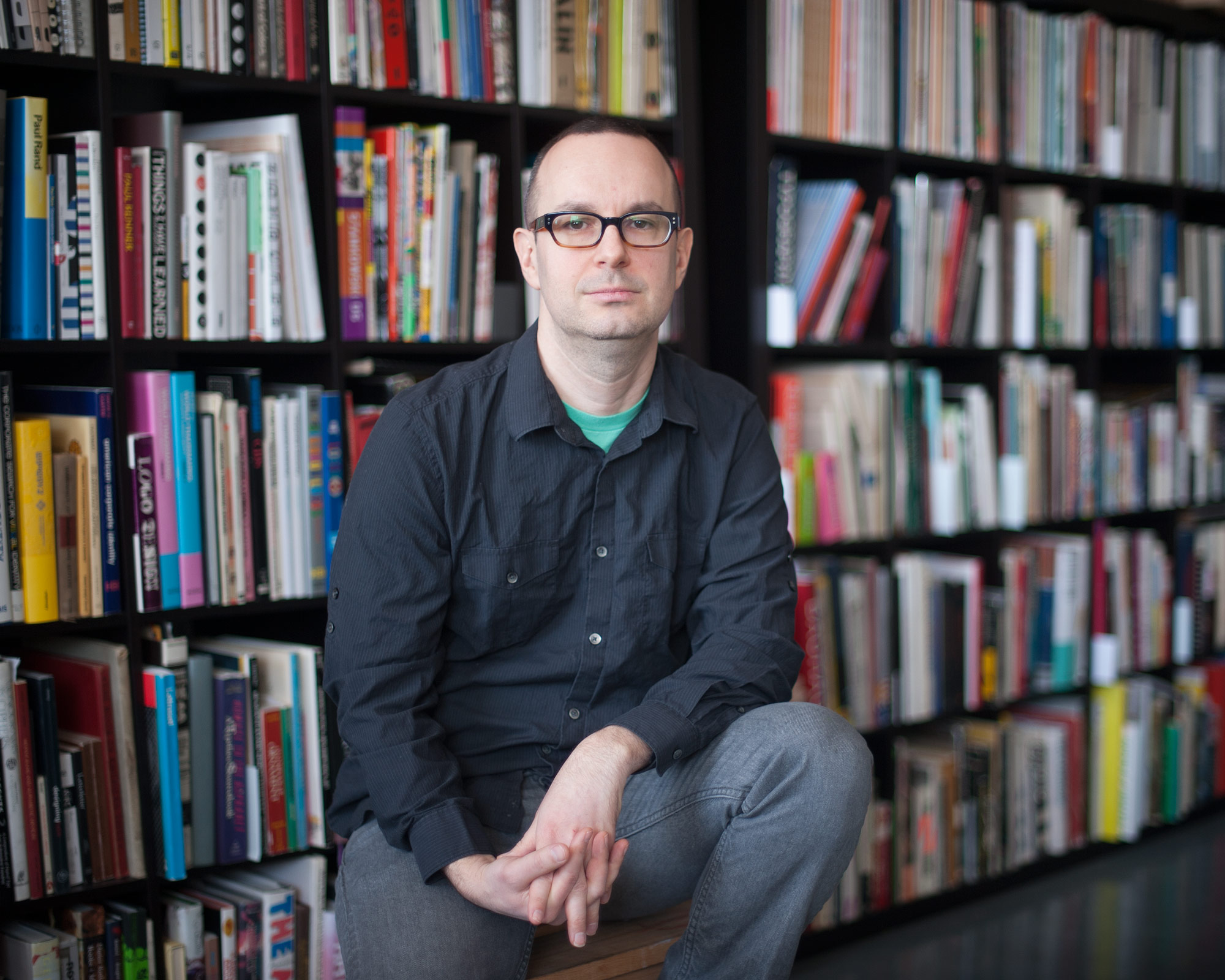
- Interview by Tina Essmaker February 18, 2014
- Photo by Tiffany Bolk
Michael Cina
- artist
- designer
- typographer
Michael Cina is a world-renowned, award-winning art director, typographer, and visual artist based in Minneapolis, Minnesota. In addition to being founder of his design agency, Cina Associates, he is also founder of famed online designer resource, YouWorkForThem. Cina is an accomplished abstract painter whose work has been exhibited worldwide and can be seen on numerous album covers for various labels, most notably, Ghostly International.
Interview
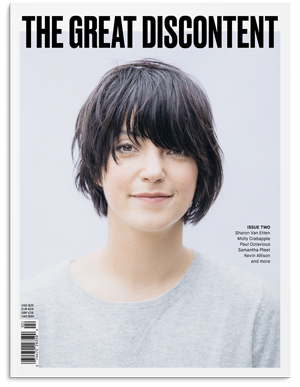 Editor’s note: A version of this interview, including new images, is featured in print in The Great Discontent, Issue Two, available in our online shop.
Editor’s note: A version of this interview, including new images, is featured in print in The Great Discontent, Issue Two, available in our online shop.
Describe your path to becoming a designer and artist.
I started off painting and doodling in notebooks as a child; I can’t ever remember not doing art. When I was a kid, my mom took me to the Art Institute of Cincinnati and I studied how to draw and paint alongside people who were much older than me—that experience was pretty life-changing. There were other defining moments in grade school. For example, I could look at a logo and notice if there was too much space between letters—I already had an eye for kerning. I also loved logos and I drew them all the time. In elementary school, I would redraw sports logos and, in high school, I got into punk rock bands like Black Flag, DRI, and the Dead Kennedys, and I sketched their logos constantly.
When I was getting ready to graduate from high school, my guidance counselor asked me what I’d like to do for a living. Both of my parents were in marketing—my dad was vice president of marketing for multiple companies and my mom was a director of marketing for a handfull of companies as well, so I didn’t fall very far from the tree. I decided to study advertising at the University of North Texas.
Are you originally from Texas?
I’m from all around. I grew up in Cincinnati, went to high school in Kansas City, and moved to Texas for college. I’ve lived in Minneapolis since 1996.
Did you have an interest in advertising?
At the time, I was only studying advertising because I didn’t know about graphic design yet. Nobody had ever really mentioned graphic design as a viable field. After two years, I switched from the advertising program to visual communication when I figured out I wasn’t ever going to be able to design anything as an ad exec.
The design program was good, but the only problem was that I didn’t take my classes very seriously. I was working as a DJ most nights, so I would half-ass all of my projects. Eventually it got bad enough that I was asked to leave the program.
They told you to leave because they didn’t think you were taking it seriously?
That, and because they didn’t think I was any good. I said, “But this is where I’m supposed to be,” and they let me back in, but I didn’t really take it any more seriously the second time around—I ended up dropping out anyway.
I was making decent money from DJ-ing, but after doing that for a while, I hit a wall and needed to do something else. My parents lived in Minneapolis, and I knew that it was a good advertising and design town to work in, so I decided to move there. I knew I didn’t want to work for an agency, though—I had a couple friends who did that, and they weren’t able to pick the work they did. It was important that I could pick the kind of work I was going to be doing and who I was doing it for. I started looking for a job and probably interviewed at 100 different places before I found a position working for the Billy Graham Association, a nonprofit organization. I stayed away from the advertising world and concentrated on getting my skills together. It was during that time that I began doing side projects like CinaHaus, Test Pilot Collective, and True is True.
How did those projects come about?
CinaHaus was a type foundry I started when I first got online in early 1996. At that time, the only other way to show your work was to get it printed up, but that was very expensive, so I saw the Internet as a great, inexpensive opportunity to show what I could do. I put all my eggs in that basket, and stayed up designing until 3am or 4am most nights.
Test Pilot Collective started a little bit later. The one designer I knew of online was typographer Chank Diesel. He had been putting up work and personal stories since 1995, and he took to online media really well. Through Chank, I met up with Matt Desmond and Joe Kral; we started Test Pilot Collective together in 1996. Test Pilot Collective became really well-known for its front page. Back then, everybody’s site had a front page, which was the first page you clicked on to get to the actual site. We decided to design a new one every day, and that got us a lot of attention online.
Matt, Joe, and I had day jobs that we worked during the week, so whoever’s office happened to be open on the weekend was the one we’d go into and work at—we’d use their computers, eat their food, and use their electricity. (laughing) In a weekend, we’d bust through a bunch of ideas and work on typefaces, and some nights we wouldn’t even go home—we would just work all night. When you’re working on a typeface, there’s a point when you have to memorize certain increments; whenever I reached that point, I’d get on a roll and wouldn’t want to stop. I loved making typefaces—it was like being asked to go play. It was the best thing I could possibly think of doing on my weekends.
Once our typefaces started selling well through Test Pilot Collective, we felt like we had a lot of clout online, but nobody in the print world took us seriously. Because of that, we started printing up postcards and posters of our work, walking into book stores, and shoving them into books. We always said, “If they’re not going to put our work in books, we’ll do it for them.” We were all book fiends, though, so we bought a ton of books from the stores at the same time, which kind of balanced out what we were doing. We hit every book store around town for three or four years, but we stopped when the Walker Art Center sent us a letter saying that they were going to report us to the police.
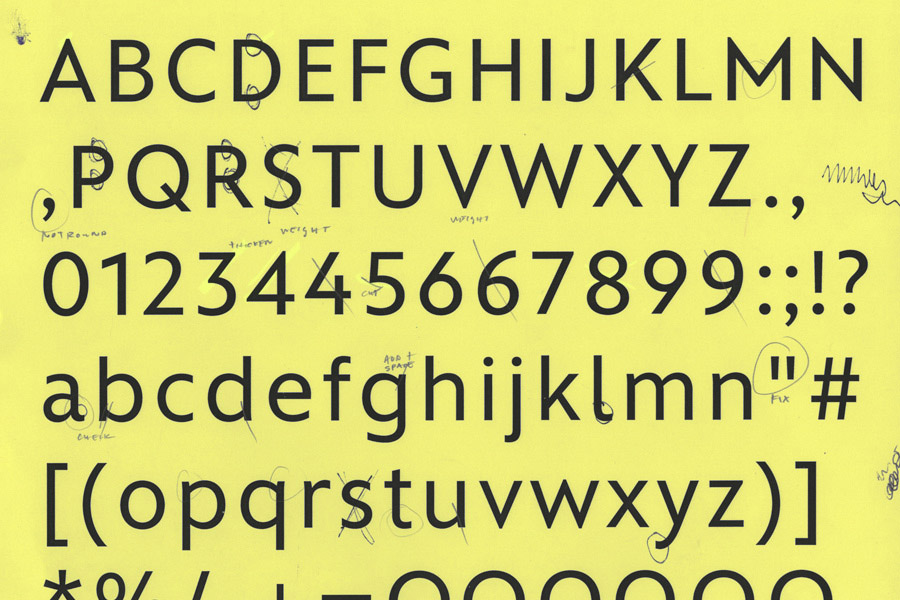
“I’ve recently had a new vision for where I want to go, and I’m going for it. If you don’t have a solid vision for where you want to go, you’re just going to meander around without doing the kind of work you really want to do.”
Were you still working at the nonprofit during that time?
Yeah, and that was a really good experience for me. I would work on 20 to 40 design projects at a time, so I was constantly figuring out how to manage a large amount of work. Some of them were easy jobs, and I realized that if I got really quick at type layouts, then I could spend more time on projects that I really liked.
How long did you work there before you made the leap to freelancing?
I started working at Billy Graham in 1996 and quit in late 1999 to set off on my own. When I started freelancing, I got great projects right away because I had already been doing a lot of personal work. I was still with Test Pilot Collective too, so I knew that I had some chance of survival. (laughing)
Have you been working as a freelancer since then?
Pretty much. I continued working with Test Pilot Collective until 2001 when I started a design agency called WeWorkForThem with Mike Young. We had cream of the crop clients: ESPN, Hewlett-Packard, Coke—you name it—and it was a really wonderful time. People told us that we were crazy to start an agency, but we did really well because we had a different vision than a traditional agency; it was more focused on our personal style. We saved up money to start selling my typefaces and that became YouWorkForThem. Not only was YouWorkForThem a way to sell my typefaces, but it was also a venue to help designers grow and flourish.
After a while, however, it became less like designing and more like running a company. I had stopped doing client work because YouWorkForThem had become a full-time job. As much as I love and hate client work, I really missed it. So, in 2010, I sold my half of the company and started my design studio, Cina Associates. I’ve been out on my own ever since, focusing on custom typefaces, branding, and art.
Did you have an “Aha!” moment when you knew you wanted to design for a living?
My “Aha!”” moment came in college when I switched from advertising to design. The design program was gearing us up to do agency work, but that seemed really boring. I was living in Dallas at the time, which meant that most of the agency clientele was in the gaming industry—board games and video games—and none of that appealed to me. In general, design wasn’t my thing because it seemed so corporate and soulless. There’s nothing wrong with doing corporate work—I love doing corporate work—but the approach to it was very stagnant. Everything was very pun-based and formulaic. I thought, “Where is the experimentation? Where is the fun of doing good design?”
Right when I was about to quit design school, I heard talks from two designers. The first was Gert Dumbar, from Studio Dumbar. I listened to him, and he really enjoyed designing. He talked about drinking on the job and how he would stick his foot out or hold a pint of beer during really elaborate photo shoots in his studio. The second guy was Dana Arnett from VSA Partners. He talked about going out to a cabin or a bar to sketch ideas, and I thought that was great. It was good for me to hear those two talk because they changed my idea of what design could be.
That was also around the time when I was working as a DJ, so I saw a lot of album cover designs. When I saw Warp Records coming out, it really spoke to me visually. Also, seeing work from David Carson and Tomato really excited me—I didn’t even think that you could get paid to do that kind of thing.
There was a book and record store in town and one day I decided to look in the book section. I found a copy of Emil Ruder’s Typographie and bought it for $8. I pored over the pages for hours on end. That’s when I got serious and started focusing on graphic design.
Have you had any mentors along the way?
I’ve never had an official mentor, but I met Wolfgang Weingart once in Minneapolis and it’s been a dream of mine to study under him. Karel Martens would also be great to study under.
I’ve actually been thinking about taking two months off to go be an apprentice with somebody, somewhere. I’ve never had that, and I get jealous when I hear people say, “I studied under Karel Martens for a couple semesters.” That melts my mind, and I think, “What an opportunity!”
“My wife has stuck with me through the really bad years and the really good years. She wants me to do great work and is willing to do whatever it takes to make that happen. I get kind of choked up talking about it, because it’s such a blessing to have someone like that in your corner.”
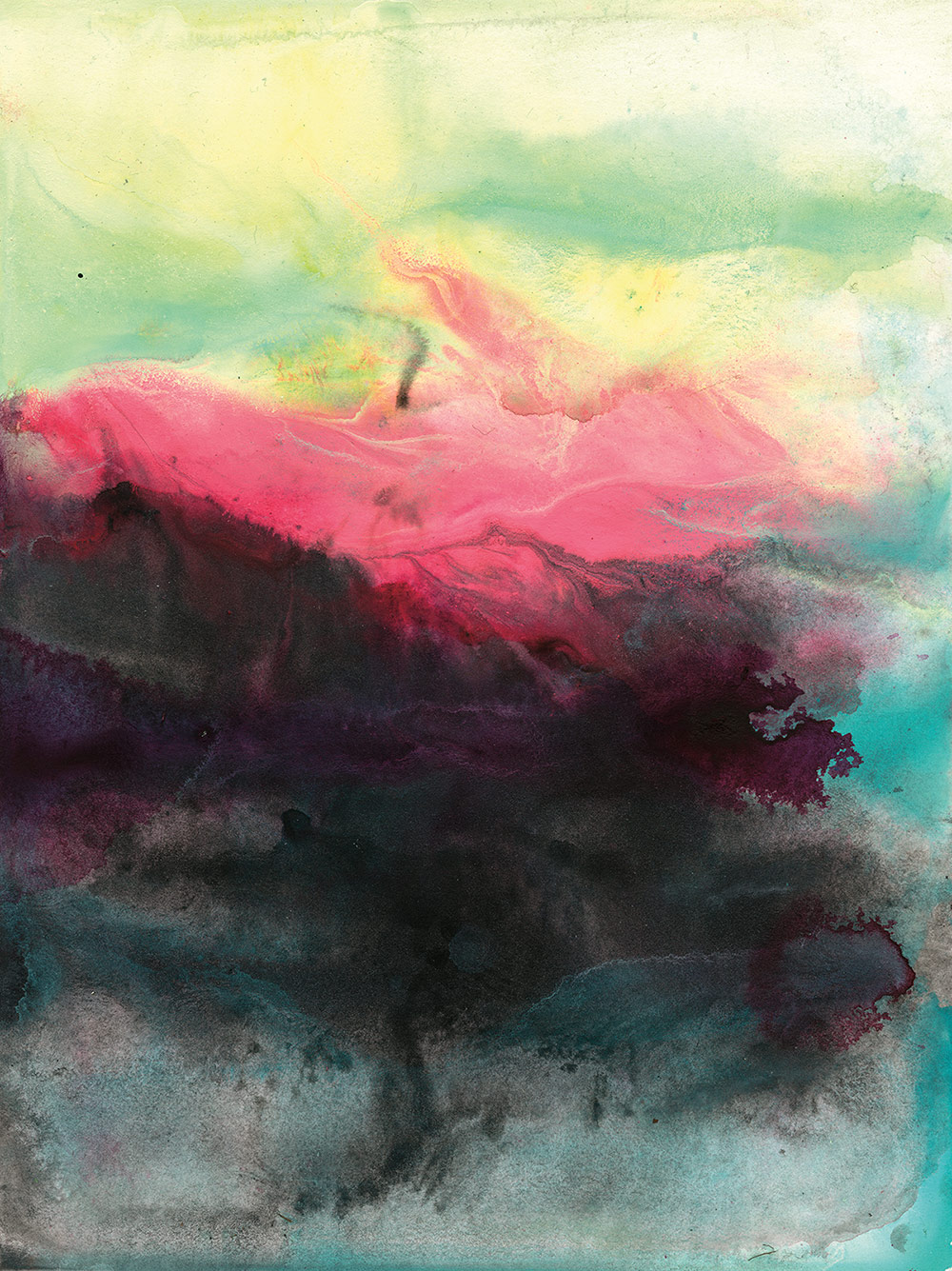
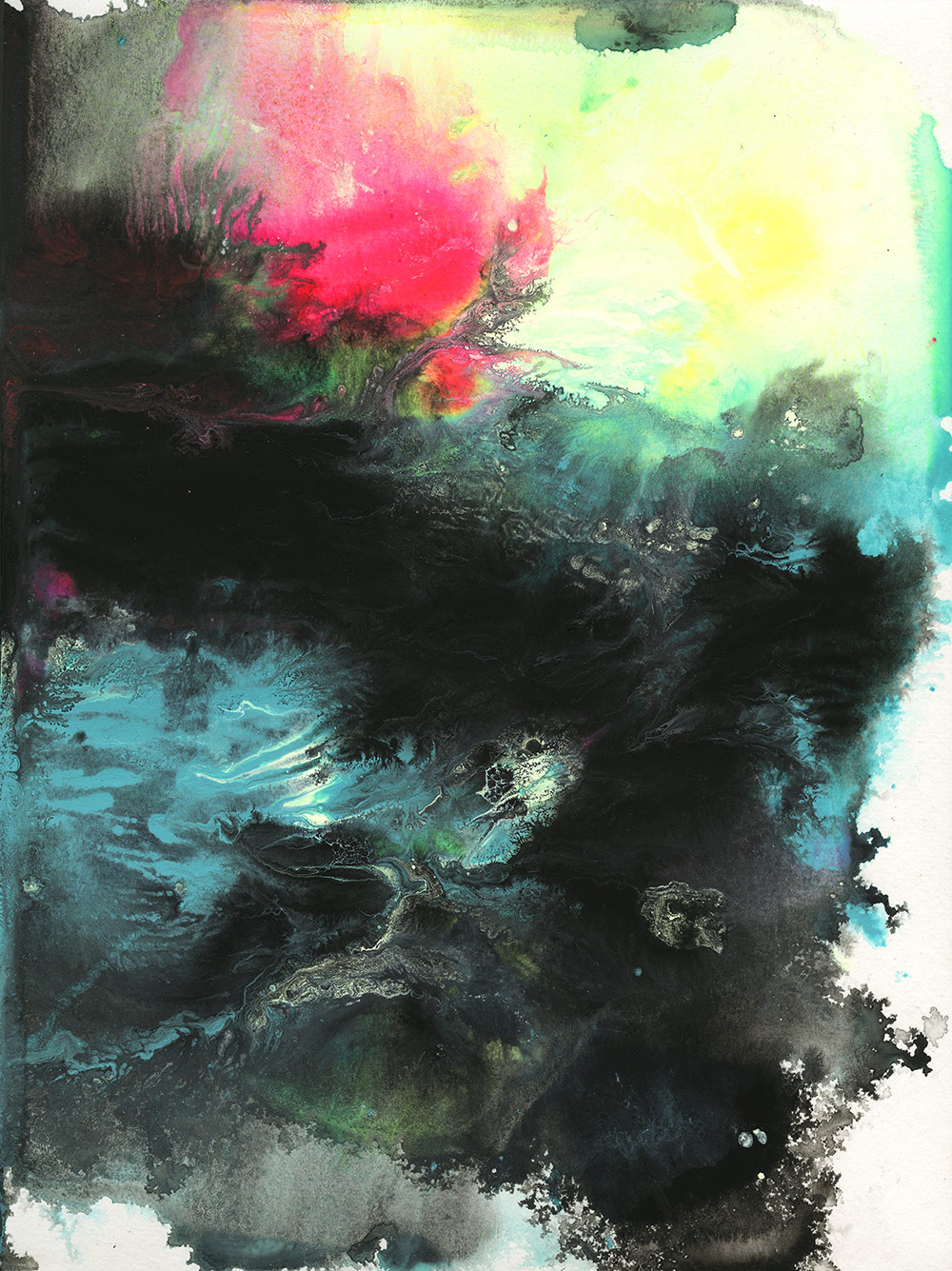
Has there been a point when you’ve taken a big risk to move forward?
I like to think I do that all the time: I try to do it daily. I have a check-in point with myself and my work every six months to make sure I’m still taking risks and moving forward. Even though I’m an older designer, I feel like my career is starting again. It’s funny to have different seasons of work. I’m on my third “life” as a designer.
You have to take risks in order to move forward—I feel very passionate about that. I always say that if you feel uncomfortable, then you know you’re doing something right. I’ve recently had a new vision for where I want to go, and I’m going for it. If you don’t have a solid vision for where you want to go, you’re just going to meander around without doing the kind of work you really want to do. Last year I made up my mind to get larger branding jobs, custom typefaces, and more gallery exhibits. This week I landed two gallery shows.
Congratulations on the shows!
Thank you! I’m very excited. One of the shows is in London and the other is here in Minneapolis. It’s a collaboration with a photographer named John Klukas, who is based in New York City. John and I have been working on some things for over a year, and I haven’t shown anybody. It sounds funny, but this is probably the most excited I’ve been in a long time! (laughing)
When is the show?
I believe that it’s May 23, 2014, at Public Functionary—at least that’s what we have penciled in.
Awesome! So, are your friends and family supportive of what you do?
Yes. The old saying is, “Behind every great man there is a great woman,” and I really believe that. My wife has stuck with me through the really bad years and the really good years. She wants me to do great work and is willing to do whatever it takes to make that happen. I get kind of choked up talking about it, because it’s such a blessing to have someone like that in your corner. I try to do the same for her.
Were your parents supportive of you becoming a designer?
My parents were supportive of me, but not necessarily the career I had chosen. They didn’t really want me to go into design. (laughing) Since they had both been in advertising and marketing, they were familiar with design, but neither of them liked it. They’ve both had bad experiences with designers and agencies, and they were worried that I wouldn’t be able to make any money.
It’s interesting that some parents encourage their kids to go into art, while others discourage it in favor of something more traditional.
It was totally the second one for me. I was the kid who said, “You don’t know what you’re talking about,” until I actually found out that design is harder than I thought it would be. Something that always boggles my mind is how many people consistently push young kids into design; I feel like it’s so over-saturated. People say that it’s a great career to be in, but nobody talks about the difficult times or hardships. I find it to be a very bizarre and superficial industry.
“Something that always boggles my mind is how many people consistently push young kids into design; I feel like it’s so over-saturated. People say that it’s a great career to be in, but nobody talks about the difficult times or hardships.”
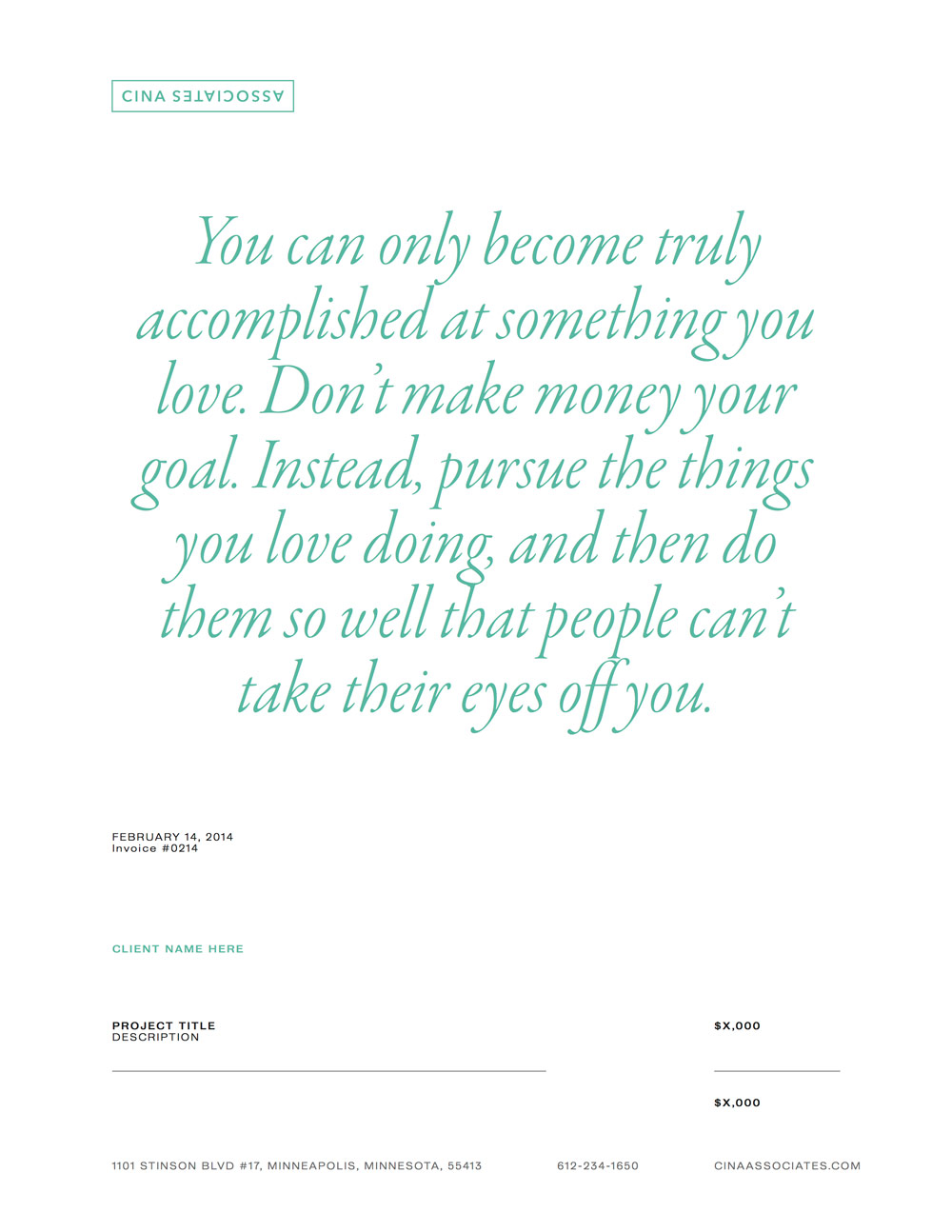
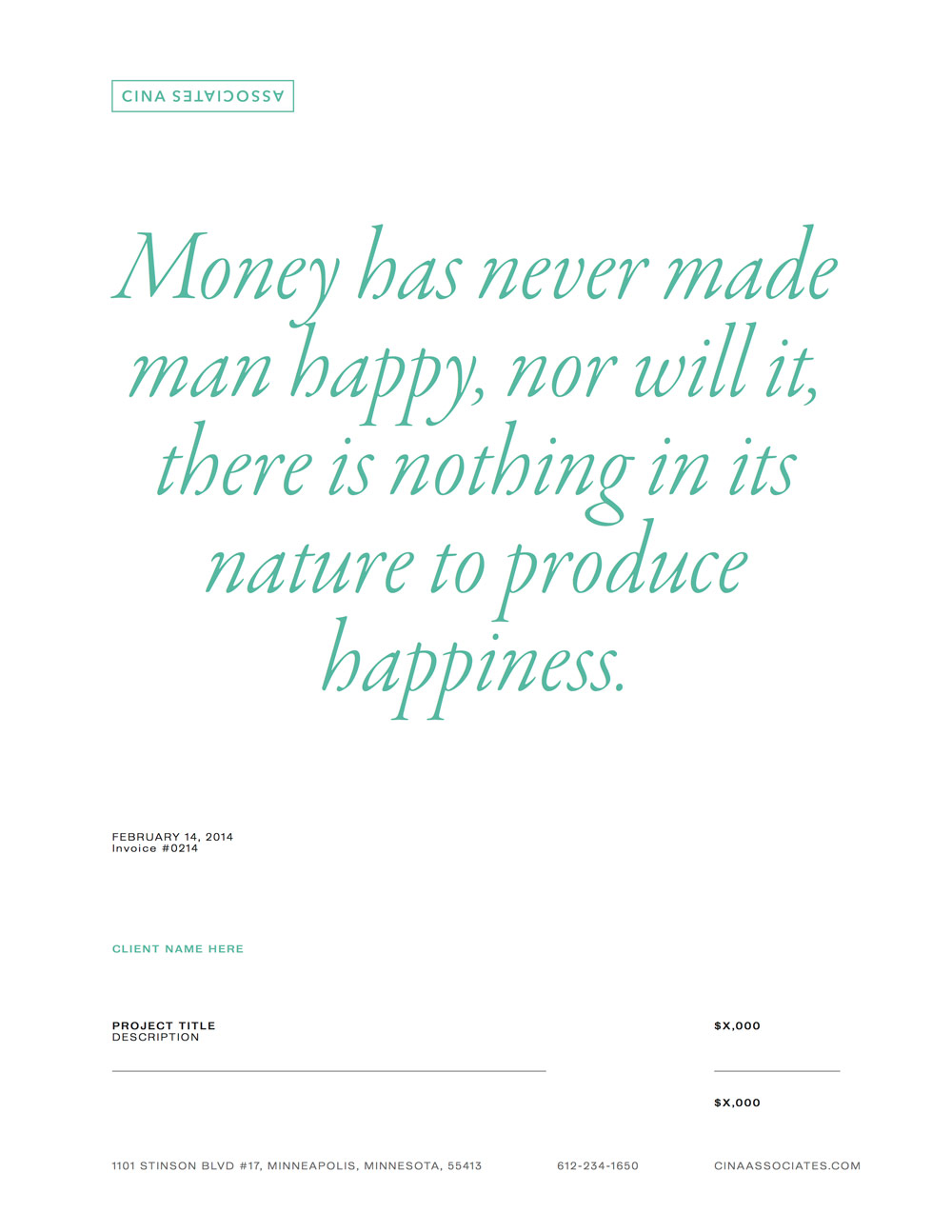
Do you feel a responsibility to contribute to something bigger than yourself?
Yeah, I do. Every year I make a list of things I want to do, and I always try to mentor one or two people each year. I feel like we’re all kind of alone here, but it’s an honor to be able to reach out to people, share something with them, and show them love. Even YouWorkForThem was initially geared toward helping designers. Trying to change the industry is too big to tackle on my own, so I just try to make a good impression on the people I work with. For instance, the invoices I send out feature quotes about how unimportant money is, how people are way more important than jobs, and things like that. I’ll send you one.
Are you creatively satisfied?
Never. I always want to do bigger and better things. I have that constant push to move past what I’ve done, so there’s never a feeling of fulfillment. I feel satisfied by the work I do, and I try to make every piece the best one I possibly can, but I think that’s what drives me nuts: I always know I can do better.
On top of that, when you have feedback from clients, there are so many hands in the process that it’s hard to do work that you’re 100% satisfied with. There have been pieces that I’m really happy with, but a lot of it is bargaining and managing expectations. People don’t get to see how hard a designer works at getting a good project through the door. I feel like some people get such great projects handed to them that they’re able to do whatever they want, but I’m constantly fighting to get better finished products.
That said, is there anything that you’re interesting in doing in the next few years?
I’m always interested in trying new things. I would like to work with 3D forms, and I actually just finished a little video piece that I’m pitching to a company. However, my main goal is to find more clients who want to do great work with a unique vision. That’s been my dream, and that’s what I’m really chasing after.
What advice would you give to a young person starting out in design?
The first thing is to work very hard. If you want anything in life, you have to work hard to get it. That’s really it. In design, I don’t know that I subscribe to the idea of people being born with talent. I was an okay designer when I was younger—actually, I was bad (laughing)—but I worked really hard at it, and I wanted it more than anything. It’s hard to find people who want it so badly that it’s all they think about. There’s a price you have to pay, and it’s putting in a lot of hours. That’s the number one thing that I tell people: work, work, work, work, work.
The only other piece of advice would be to find out what you want to do, and then go for it. You don’t have to specialize in one thing. Even if it’s a combination of things, there are many fields within design now, so you can find what you’re looking for.
That’s true. Many of the people we talk to advise to work hard. We just quit our day jobs, but it took almost three years of working on TGD during evenings and weekends to get to this point.
Isn’t it exciting to be out on your own? (laughing)
Yeah, it is. We’re nervous, but also very excited.
It’s about taking those leaps of faith. You have to know when you’re being smart and when you’re being dumb, but the hardest part is knowing which one it is. I’ve done a lot of foolish things in my day, but they panned out because I believed in them so much. (laughing)
We believe in this. It is a risk, but the timing feels right, and everyone we’ve shared it with has been really excited for us.
Getting a community together is really important. You can sell anything if you get enough people excited about it in a genuine way, but I’m horrible at that. I just say: “I did this project. Look at it if you want.” (laughing) That said, I feel very fortunate that people appreciate my work as much as they do; I’m not exactly the best promoter.
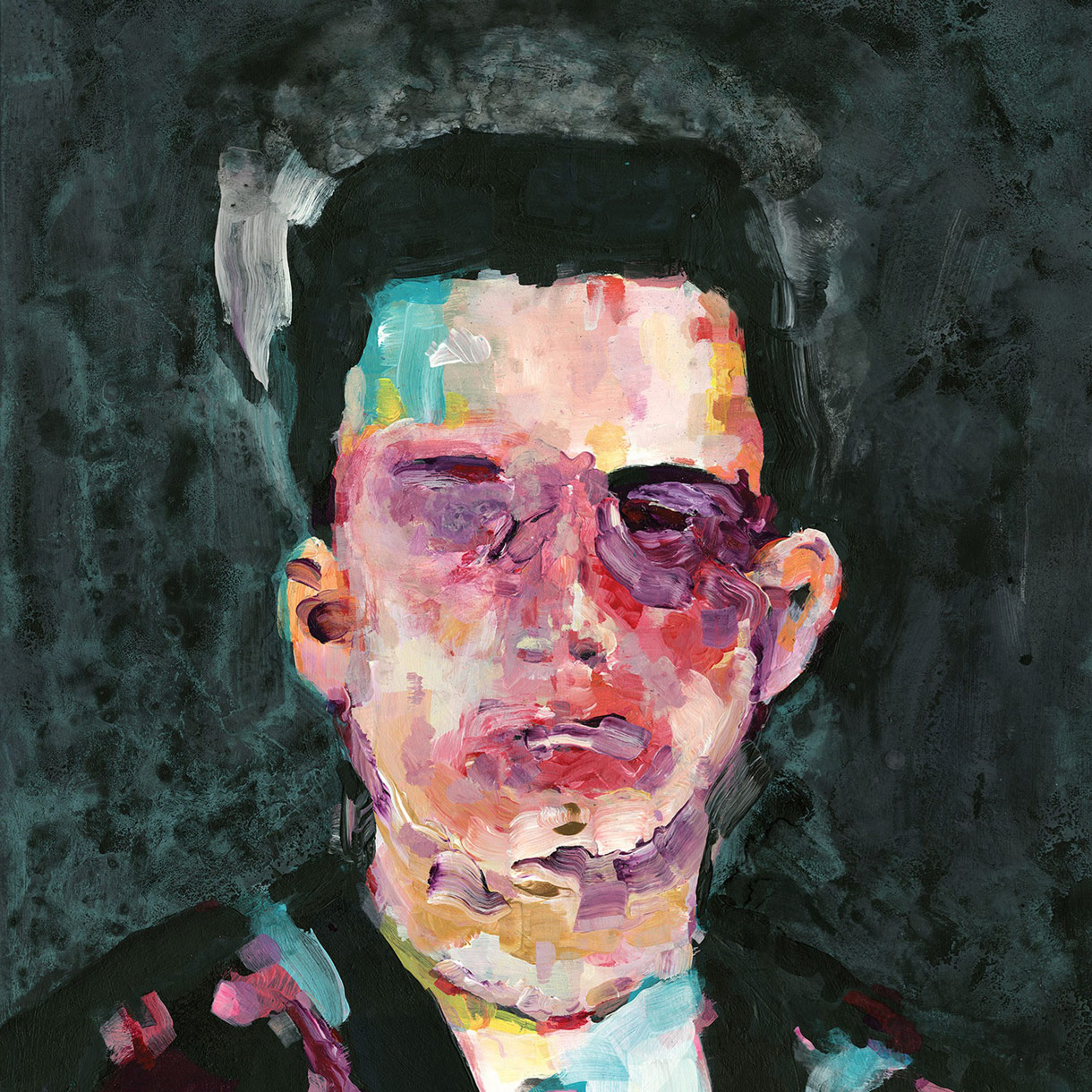
“If you want anything in life, you have to work hard to get it. That’s really it…It’s hard to find people who want it so badly that it’s all they think about. There’s a price you have to pay, and it’s putting in a lot of hours. That’s the number one thing that I tell people: work, work, work, work, work.”
Is it important for you to be a part of a creative community?
I don’t have a community, but I have a couple friends who I talk with. I gravitate towards anybody who is genuinely interested in life, thinking, and growing, whether they are designers or not. I also feel like there is a class system in design and it genuinely hurts me to see that on a daily basis.
Does living in Minneapolis impact your creativity or work?
I like Minneapolis because you can become anonymous really easily; you can blend in and do whatever you want. I also like that you can get away into nature. Minneapolis is a very nice town to live in because it’s not stressful. I love to visit cities like New York, but there is so much shit you have to deal with—even getting a ride home can be maddening! Plus I get sensory overload really easily because I’m interested in so many things. When I go to New York, I’m literally looking in every window.
What does a typical day look like for you?
Every day is different: that’s one of the reasons why I do what I do. I like getting into the office earlier rather than later, but I have two children who really prohibit me from getting in at a decent time. (laughing) I used to love coming into work at 6am, but that ship has sailed. Now, I get in around 9am and try to leave as soon as I can. People tell me, “I don’t know how you work on your own,” but when I’m here, I’m working. Something I like about having a more industrial space is that I can mess it up and get paint everywhere. It’s not comfortable; I have a couch here, but I don’t want to hang out on it. When I’m at work, I work. That’s why I never wanted to work for agencies that have comfortable couches and video games. That means that you’re there long enough to use it—you’re there all night so you need a pool table or a ping pong table. No way!
The work I do on any given day is varied. I just did a bunch of branding for Hallmark. Between jobs I do work for a few branding agencies and help them out on projects, and I’m always working on something for Ghostly International. If the day is slow, or if I don’t feel like working, I’ll paint or clean. Today I had a meeting with a gallery and sent out invoices. It’s really not that exciting, but there’s no typical day. (laughing) I don’t really have a schedule or rituals or anything like that—it’s just complete chaos.
Is there any music that you’re enjoying right now?
I’ve been listening to a lot of Bohren & der Club of Gore. It’s really dark, moody jazz, and I really like their newest album, Piano Nights. I love Lone, too: that’s a staple. Recently, I’ve really been enjoying Hiatus Kaiyote’s Tawk Tomahawk record, but I listen to pretty much everything. I like drone music, jazz, soul, ambient, hip-hop, and electronic.
I have a really crazy record collection, and I’ve been going through my soul section to find records I can sell or get rid of. I pulled out about 700 records, but that’s less than half of what I have in my soul section alone. My jazz collection consists of two five-by-five Ikea shelves—in total, I have about 15,000 records. I’ve been trying to reduce my collections and live simply, but I’m addicted to buying books and records. It’s not something I am proud of anymore.
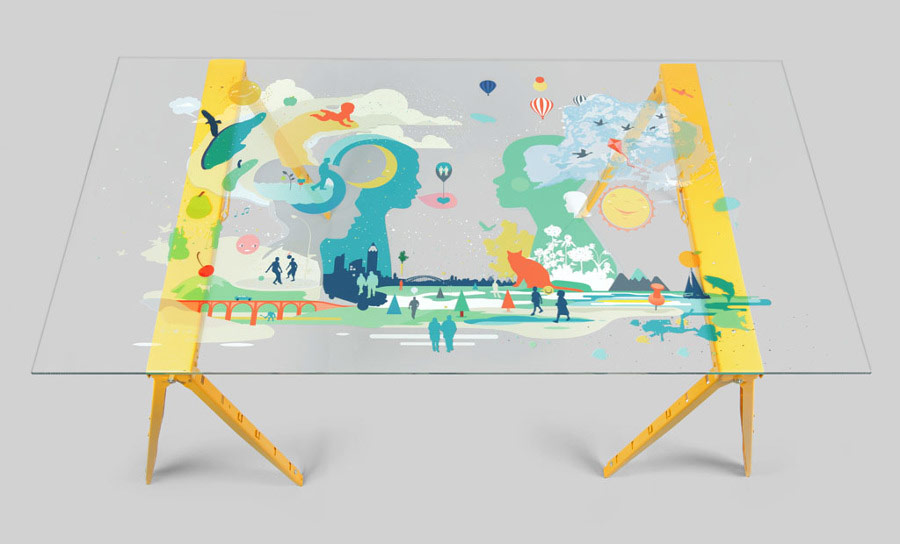
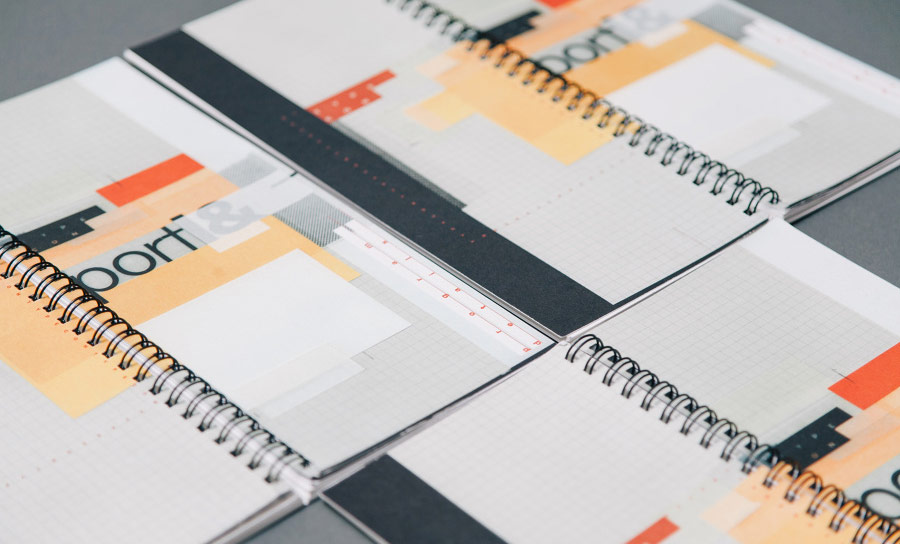
Do you have any favorite movies or TV shows?
I really enjoy Curb Your Enthusiasm, and my wife and I watch Parks and Recreation and Modern Family all the time. Otherwise, I don’t watch TV because I don’t have time for it.
For movies, I like indies and anything that is open-ended. If I could, I wouldn’t watch the last 10 minutes of anything: I usually hate the endings, so I’d rather not know. Some weave good stories, like Inception, but I usually approach movies from an aesthetic standpoint. I really like Andrei Tarkovsky, the director of the original Solaris and The Mirror. The Mirror is probably one of my favorite movies because it’s so visually stunning and nonlinear.
What are your favorite books?
One of the best books I’ve gotten in years is Typografische Monatsblätter from Lars Müller. If you like the Swiss, minimal typographic style, it is just phenomenal. I highly suggest at least looking at it in a book store, even if you don’t buy it. I also like UK designer Gerald Cinamon’s book, Graphic Design.
I like weirder design books, and some of my favorite genres are Japanese and Dutch. I think Unit Editions has some of the best books—they are probably my favorite publisher right now.
What is your favorite food?
Well, I have bad stomach problems—which is not the answer you wanted to hear (laughing)—so I started eating non-processed foods about a year ago. Now I have to cook everything myself, and it’s a pain in the ass. (laughing) I’m a researcher of food. For instance, if I want to drink wine, I want to know what I’m drinking, what the best kind is, and why; I go really deep into it. But I can’t have any alcohol, coffee, milk, or gluten now, so I just eat fresh vegetables and fruits most of the time, although I do eat meat.
What kind of legacy do you hope to leave?
Oddly enough, I think about that a lot. What would happen if I died? I think that’s one of the many reasons why I’m purging my book and music collection right now: I’d just hate to weigh down my family with all my stuff. What are they going to do with it all? I have five flat files full of art, too.
When it comes down to it, you don’t really control what happens with your work after you die. Part of me wants to tell my wife to sell everything. I don’t need the praise or the accolades anymore; I don’t have the desire to get peer feedback or approval. For me, it’s about being a genuinely good person. I would hope that people would say, “He could be a dick sometimes, but he was sincerely a nice guy who was willing to help others.” I don’t want to be that asshole that everybody hated. (laughing) I would like to be known as somebody who did great work, loved his family, and helped and cared for everyone he met.
Other than that, I don’t really know how to answer this question.
“I always want to do bigger and better things. I have that constant push to move past what I’ve done, so there’s never a feeling of fulfillment. I feel satisfied by the work I do, and I try to make every piece the best one I possibly can, but I think that’s what drives me nuts: I always know I can do better.”
